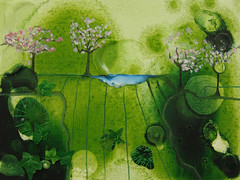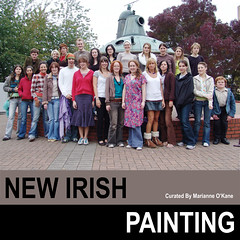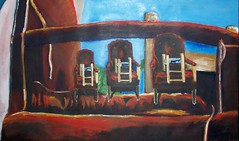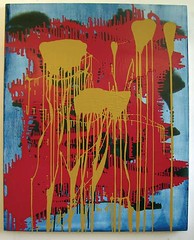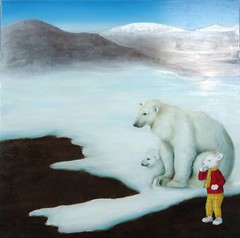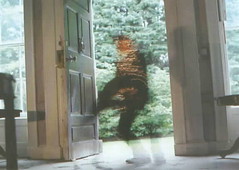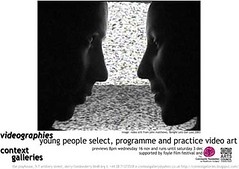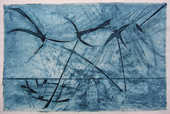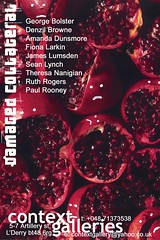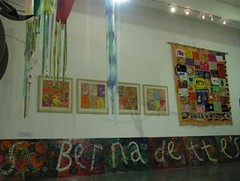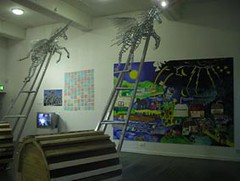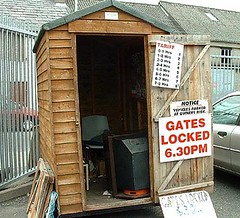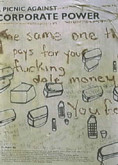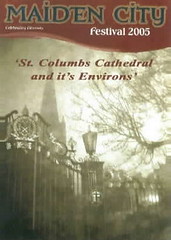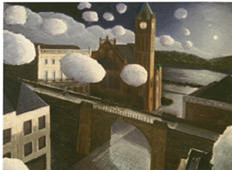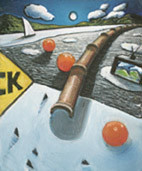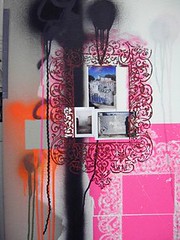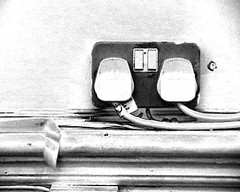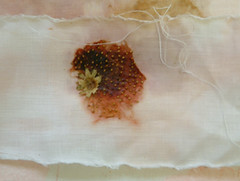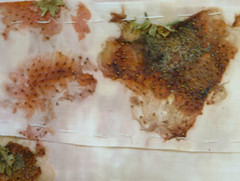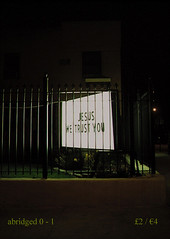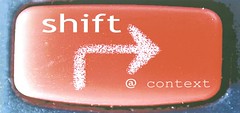New Irish Painting
New Irish Painting
an introduction by Robert Armstrong, Head of Painting, NCAD
Making art is full of new beginnings. Every day, every work, every false start, every Eureka moment, every doubt and hesitation, every mistake . . . every new beginning (again!) until finally the work is shown and then starts the beginning of another process involving the audience.
The recent resurgence in popularity of painting is welcome, though it can’t be long before painting again will be diagnosed with terminal illness. Rude good health has encouraged a burgeoning of exciting new painting practice. Diversity is in - even within individual practice. No one ideology is driving painting practice. No one style is dominant. Anything goes! Perhaps now more than ever. Painting is moving out of the galleries, off the walls, into computer animation software – travelling wherever it may to interrogate its history and to satisfy the hopes and challenges set by the young artists who choose to work with and extend the potential of the medium. This is simultaneously a liberation and a challenge.
These students of the National College of Art & Design Painting Department are at the beginning of their careers, and they are up for the challenge. Their work is full of the excitement and optimism that would be expected. They welcome this opportunity to exhibit their work, and NCAD is happy to support them with this exhibition in the Context Galleries in Derry. We acknowledge in particular the enthusiasm of Marianne O’Kane in curating this exhibition.
NCAD /CONTEXT GALLERIES EXHIBITION
'New Irish Painting'
Forthcoming at Context Galleries in December 2005, is an important exhibition, entitled 'New Irish Painting' by twenty-five final year BA Fine Art Painting students from the National College of Art and Design. This is an innovative one off exhibition curated by Marianne O'Kane, Curator of Cavanacor Gallery and a member of the Context Board of Directors.
This is the largest group survey exhibition of painting at the Context Galleries to date. The Context Galleries are renowned for platforming the practise of young graduates and emerging artists and yet this exhibition also illustrates the importance of the art institution itself, in that all students are in their final months of art education. There is a tendency for Fine Art graduates to focus on conceptual and lens based practise after completing their training and while this is valid and noteworthy, 'New Irish Painting' focuses solely on painting and profiles the best work of the students in this discipline. The exhibition will feature one representative work by each participant. The students are from throughout Ireland, north and south. There is a vibrant and diverse range of painting full of experimental fervour and creative passion.
The Curator has identified a unique dynamic in the art college, where collaborative workshops and discussion naturally occur between the students. It is being curated through a series of college and studio visits, accompanied by discussions with the participating group. NCAD have commended the venture as the first of its kind and a unique North/South collaboration. A publication, funded by the Arts Council of Northern Ireland and the National College of Art and Design will accompany the exhibition. This catalogue contains a feature essay by Marianne O'Kane, Curator and a Foreword by Robert Armstrong Head of Painting at the National College of Art and Design.
The participating students are: Maire O'Mahony, Oisin Byrne, Louise Butler, Lucy Sheridan, Matthew O'Kane, Carol Anne McGowan, Priscila Fernades, Kim McGlynn, Sarah O'Neill, Emer G. McKeever, Anne Hendrick, Rachel Egan, Jane Hughes, Emma Roche, David O'Kane, Aoife Miskella, Amy Sheridan, Tempy Osborne, Fiona Chambers, Liam Ryan, Mark Simpson, Maria Hildrick, Sophie Loughnan, Samantha Clarke and Olive Ambroise. 'New Irish Painting' provides a unique opportunity to view the work of up and coming names in the Irish art world and purchase their work.
10 December 2005 – 21 January 2006
an introduction by Robert Armstrong, Head of Painting, NCAD
Making art is full of new beginnings. Every day, every work, every false start, every Eureka moment, every doubt and hesitation, every mistake . . . every new beginning (again!) until finally the work is shown and then starts the beginning of another process involving the audience.
The recent resurgence in popularity of painting is welcome, though it can’t be long before painting again will be diagnosed with terminal illness. Rude good health has encouraged a burgeoning of exciting new painting practice. Diversity is in - even within individual practice. No one ideology is driving painting practice. No one style is dominant. Anything goes! Perhaps now more than ever. Painting is moving out of the galleries, off the walls, into computer animation software – travelling wherever it may to interrogate its history and to satisfy the hopes and challenges set by the young artists who choose to work with and extend the potential of the medium. This is simultaneously a liberation and a challenge.
These students of the National College of Art & Design Painting Department are at the beginning of their careers, and they are up for the challenge. Their work is full of the excitement and optimism that would be expected. They welcome this opportunity to exhibit their work, and NCAD is happy to support them with this exhibition in the Context Galleries in Derry. We acknowledge in particular the enthusiasm of Marianne O’Kane in curating this exhibition.
NCAD /CONTEXT GALLERIES EXHIBITION
'New Irish Painting'
Forthcoming at Context Galleries in December 2005, is an important exhibition, entitled 'New Irish Painting' by twenty-five final year BA Fine Art Painting students from the National College of Art and Design. This is an innovative one off exhibition curated by Marianne O'Kane, Curator of Cavanacor Gallery and a member of the Context Board of Directors.
This is the largest group survey exhibition of painting at the Context Galleries to date. The Context Galleries are renowned for platforming the practise of young graduates and emerging artists and yet this exhibition also illustrates the importance of the art institution itself, in that all students are in their final months of art education. There is a tendency for Fine Art graduates to focus on conceptual and lens based practise after completing their training and while this is valid and noteworthy, 'New Irish Painting' focuses solely on painting and profiles the best work of the students in this discipline. The exhibition will feature one representative work by each participant. The students are from throughout Ireland, north and south. There is a vibrant and diverse range of painting full of experimental fervour and creative passion.
The Curator has identified a unique dynamic in the art college, where collaborative workshops and discussion naturally occur between the students. It is being curated through a series of college and studio visits, accompanied by discussions with the participating group. NCAD have commended the venture as the first of its kind and a unique North/South collaboration. A publication, funded by the Arts Council of Northern Ireland and the National College of Art and Design will accompany the exhibition. This catalogue contains a feature essay by Marianne O'Kane, Curator and a Foreword by Robert Armstrong Head of Painting at the National College of Art and Design.
The participating students are: Maire O'Mahony, Oisin Byrne, Louise Butler, Lucy Sheridan, Matthew O'Kane, Carol Anne McGowan, Priscila Fernades, Kim McGlynn, Sarah O'Neill, Emer G. McKeever, Anne Hendrick, Rachel Egan, Jane Hughes, Emma Roche, David O'Kane, Aoife Miskella, Amy Sheridan, Tempy Osborne, Fiona Chambers, Liam Ryan, Mark Simpson, Maria Hildrick, Sophie Loughnan, Samantha Clarke and Olive Ambroise. 'New Irish Painting' provides a unique opportunity to view the work of up and coming names in the Irish art world and purchase their work.
10 December 2005 – 21 January 2006
portraits of ali
portraits of ali
colin peck
Context Galleries presents an exhibition of new photographs by Colin Peck, the internationally known documentary filmmaker based in Prehen House, Derry.
The photographs, collectively known as Portraits of Ali are an intense series of experimental portraits using long exposure and medium format photography.
Colin Peck has worked as documentary filmmaker throughout Europe and Asia, with his works broadcast by most major networks including ARTE, BBC, ARD, ABC, NHK, RTL.
Exhibition previews Saturday 26th November at 8pm.
Exhibition continues until December 3rd.
colin peck
Context Galleries presents an exhibition of new photographs by Colin Peck, the internationally known documentary filmmaker based in Prehen House, Derry.
The photographs, collectively known as Portraits of Ali are an intense series of experimental portraits using long exposure and medium format photography.
Colin Peck has worked as documentary filmmaker throughout Europe and Asia, with his works broadcast by most major networks including ARTE, BBC, ARD, ABC, NHK, RTL.
Exhibition previews Saturday 26th November at 8pm.
Exhibition continues until December 3rd.
Videographies
Context Galleries presents a specially programmed event as a parallel to the Foyle Film Festival 2005:
Videographies
In March 2005, filmmaker Tracy Cullen approached Context Galleries with a concept for an exhibition which would open up to young people both the medium and the practice of art using video. With the generous support of The Community Foundation for Northern Ireland Use Your Imagination Award, we have been able to present this as a key commitment to our Outreach process and to supporting emerging artists.
In this unique exhibition and access project, a team of young people from a rich multiplicity of backgrounds have collectively selected, programmed and designed a Context Galleries exhibition, on the theme of peace-building, of art works on video. These videos were responses to our calls to artists to submit works on that theme. As part of the team’s process of exploring the idea of peace-building and the medium of video, they have also made their own video on that theme, with filmmaker Tracy Cullen.
The videographers are:
Andrew Boyle
Rosanne Dowling
Erin McDevitt
Conor Norris
Simona Spinola
The artists from Ireland, Finland, Scotland and USA that they have selected are:
Bronwen Casson
Jacqueline Galvin
Stephen Gunning
Elina Hartzell
John Matthews
Ailie Rutherford
Lee Welch
Exhibition opens at 8pm, Wednesday 16 November
Exhibition continues until December 3
Videographies
In March 2005, filmmaker Tracy Cullen approached Context Galleries with a concept for an exhibition which would open up to young people both the medium and the practice of art using video. With the generous support of The Community Foundation for Northern Ireland Use Your Imagination Award, we have been able to present this as a key commitment to our Outreach process and to supporting emerging artists.
In this unique exhibition and access project, a team of young people from a rich multiplicity of backgrounds have collectively selected, programmed and designed a Context Galleries exhibition, on the theme of peace-building, of art works on video. These videos were responses to our calls to artists to submit works on that theme. As part of the team’s process of exploring the idea of peace-building and the medium of video, they have also made their own video on that theme, with filmmaker Tracy Cullen.
The videographers are:
Andrew Boyle
Rosanne Dowling
Erin McDevitt
Conor Norris
Simona Spinola
The artists from Ireland, Finland, Scotland and USA that they have selected are:
Bronwen Casson
Jacqueline Galvin
Stephen Gunning
Elina Hartzell
John Matthews
Ailie Rutherford
Lee Welch
Exhibition opens at 8pm, Wednesday 16 November
Exhibition continues until December 3
The Moving Image… Magic boxes and story films...Boscaí Draíochta agus Scannáin Seanchais
Context Galleries presents specially programmed events in parallel with the Foyle Film Festival 2005:
The Moving Image… Magic boxes and story films
Boscaí Draíochta agus Scannáin Seanchais
A collaboration between Jan Caspers and artists from three different countries, Catherine Chaumont of Québec, Canada, Ian Joyce of Donegal, Ireland and Julia Oschatz of Germany, ‘The Moving Image’ combines traditional printmaking with the moving images of early story film reels thus drawing an interesting parallel to the contemporary Foyle Film Festival which takes place at the same time.
Each artist presents three print cycles. The prints will eventually be mounted on conveyor belts and operated as continuous loops in mechanical screen cases. Thus only one set of three images will remain visible at any time, resulting in ever changing aspects of the landscapes, stories and abstract representations that form the subject of the cycles.
Born in Germany, Jan Caspers has worked in the medium of story and shadow films for a number of years. In the summer of 2003 he brought together three visual artists as part of an Údaras na Gaeltachta project entitled ‘Boscaí Draíochta – Scannáin Seanchais’. This project aimed to complement the work of schoolchildren who had made story films of their own with the work of artists with different visual vocabularies.
Catherine Chaumont is from Québec and works as a printmaker and piano teacher in Montréal. Her main interest is in the combination of visual art with language and music.
Ian Joyce is from Ireland and works as a printmaker and audiovisual artist in Donegal. He runs Cló Ceardlann na gCnoc, a printmaking workshop and artists’ resource centre in Bunbeg in the Donegal Gaeltacht.
Julia Oschatz is from Germany and works as a painter and visual artist in Frankfurt. She has exhibited widely in Germany, Switzerland, Austria and Iceland and New York.
Preview Wednesday November 16th. Runs until December 3rd 2005.
The Moving Image… Magic boxes and story films
Boscaí Draíochta agus Scannáin Seanchais
A collaboration between Jan Caspers and artists from three different countries, Catherine Chaumont of Québec, Canada, Ian Joyce of Donegal, Ireland and Julia Oschatz of Germany, ‘The Moving Image’ combines traditional printmaking with the moving images of early story film reels thus drawing an interesting parallel to the contemporary Foyle Film Festival which takes place at the same time.
Each artist presents three print cycles. The prints will eventually be mounted on conveyor belts and operated as continuous loops in mechanical screen cases. Thus only one set of three images will remain visible at any time, resulting in ever changing aspects of the landscapes, stories and abstract representations that form the subject of the cycles.
Born in Germany, Jan Caspers has worked in the medium of story and shadow films for a number of years. In the summer of 2003 he brought together three visual artists as part of an Údaras na Gaeltachta project entitled ‘Boscaí Draíochta – Scannáin Seanchais’. This project aimed to complement the work of schoolchildren who had made story films of their own with the work of artists with different visual vocabularies.
Catherine Chaumont is from Québec and works as a printmaker and piano teacher in Montréal. Her main interest is in the combination of visual art with language and music.
Ian Joyce is from Ireland and works as a printmaker and audiovisual artist in Donegal. He runs Cló Ceardlann na gCnoc, a printmaking workshop and artists’ resource centre in Bunbeg in the Donegal Gaeltacht.
Julia Oschatz is from Germany and works as a painter and visual artist in Frankfurt. She has exhibited widely in Germany, Switzerland, Austria and Iceland and New York.
Preview Wednesday November 16th. Runs until December 3rd 2005.
Piece
Piece
...an exhibition of Craft, Applied Art and Design loosely based on the theme of "peace".
Thirteen artists were selected by a prestigious selection panel to exhibit a very diverse range of work. From ceramics, jewellery, glass, textiles and mixed media, this new exhibition organised by Craftmark is a unique opportunity to view work inspired by the artists' very personal interpretation of the theme.
The exhibition was opened by Her Worship the mayor, Councillor Lynn Fleming.
Tuesday 15th November 2005 until Tuesday 22nd November.
Presented at the Context Galleries by Craftmark in association with the Economic Development Section, Derry City Council.
For more information see:
http://www.craftmark.ie/html/exhibitions.asp
...an exhibition of Craft, Applied Art and Design loosely based on the theme of "peace".
Thirteen artists were selected by a prestigious selection panel to exhibit a very diverse range of work. From ceramics, jewellery, glass, textiles and mixed media, this new exhibition organised by Craftmark is a unique opportunity to view work inspired by the artists' very personal interpretation of the theme.
The exhibition was opened by Her Worship the mayor, Councillor Lynn Fleming.
Tuesday 15th November 2005 until Tuesday 22nd November.
Presented at the Context Galleries by Craftmark in association with the Economic Development Section, Derry City Council.
For more information see:
http://www.craftmark.ie/html/exhibitions.asp
Damaged Collateral
Damaged Collateral:
Inner City Gothic
And the Suburban Sublime
George Bolster – Denzil Browne – Amanda Dunsmore
Fiona Larkin – James Lumsden – Sean Lynch
Theresa Nanigian – Ruth Rogers
Bird Flu, Binge Drinking, Anti – Social Behaviour, Suicide Bombers and Global Warming. Fear is Man’s best friend. Paranoia is on first name terms. ‘Damaged Collateral: Inner City Gothic and the Suburban Sublime’ the new exhibition at Context Galleries sheds light on our various demons. From the playful to the downright sinister Damaged Collateral explores the fear that haunts modern living and the failure of political and philosophical utopias. Theresa Nanigian explores the constantly shifting zone between stagnation and anarchy and spontaneous adaptability while George Bolster documents the insidious and sometimes blatant marketing of violence to children through toys and games. Ruth Rogers takes innocuous images from newspaper colour supplements and subverts them into carrying highly-charged messages using only the intervention of correction fluid and the newspaper's own main headline. Sean Lynch details crowd barriers, stacked for potential use at urban gatherings such as July 12 in Belfast, Columbus day in New York and St Patrick’s Day in Dublin. The visuality around these objects presents the clear agendas that we, as urban dwellers, must deal with. Amanda Dunsmore documents abandoned building complexes in Weimar, in Eastern Germany, constructed by the Nazis and appropriated by the Soviets, their decaying rooms holding more than remnants of ideologies. James Lumsden’s work is from into two distinct yet related series; Fascination aims to reflect the power of propaganda to manipulate, seduce and coerce - where fictions can be seen to become truths through constant repetition. In the paintings Revelation and Disclosure an illusion of light is highlighted as a fabrication by the exposure within the picture plane of the underlying material support. If the illusory light is seen as a metaphor for an unattainable utopian perfection, the revelation of the material reality beneath the painting acts as a reminder to question, to look beneath the surface of what is perceived. Fiona Larkin also questions the media she uses, this time photography in a series of three works which use elements of collage to disrupt the perfect surface of the photographs. Denzil Browne uses pin-hole camera techniques in a series of night time images, the long exposure time depopulating the works creating eerie atmospheric nightscapes filled with tension and the probability of trouble.
Works
Sean Lynch: Social Sculpture 1, 2 & 3 (2005)
Fiona Larkin: The Kindness of Strangers (2005)
George Bolster: Conditioned: Follow – Off to School – Distraction – Text – Playground (2003 A0 Lazerjet Print)
Ruth Rogers
Denzil Browne
Amanda Dunsmore: ‘Peripherie' 5 minute loop with separate CD audio
(1997 – 2004)
James Lumsden: Revelation; Fascination (Polyptych)
Theresa Nanigian – Threshold (2004)
27th October – 12th November 2005
Including
War of the WorldsA recreation of the infamous Orson Welles radio broadcast
By the Orbit Theatre Company
Inner City Gothic
And the Suburban Sublime
George Bolster – Denzil Browne – Amanda Dunsmore
Fiona Larkin – James Lumsden – Sean Lynch
Theresa Nanigian – Ruth Rogers
Bird Flu, Binge Drinking, Anti – Social Behaviour, Suicide Bombers and Global Warming. Fear is Man’s best friend. Paranoia is on first name terms. ‘Damaged Collateral: Inner City Gothic and the Suburban Sublime’ the new exhibition at Context Galleries sheds light on our various demons. From the playful to the downright sinister Damaged Collateral explores the fear that haunts modern living and the failure of political and philosophical utopias. Theresa Nanigian explores the constantly shifting zone between stagnation and anarchy and spontaneous adaptability while George Bolster documents the insidious and sometimes blatant marketing of violence to children through toys and games. Ruth Rogers takes innocuous images from newspaper colour supplements and subverts them into carrying highly-charged messages using only the intervention of correction fluid and the newspaper's own main headline. Sean Lynch details crowd barriers, stacked for potential use at urban gatherings such as July 12 in Belfast, Columbus day in New York and St Patrick’s Day in Dublin. The visuality around these objects presents the clear agendas that we, as urban dwellers, must deal with. Amanda Dunsmore documents abandoned building complexes in Weimar, in Eastern Germany, constructed by the Nazis and appropriated by the Soviets, their decaying rooms holding more than remnants of ideologies. James Lumsden’s work is from into two distinct yet related series; Fascination aims to reflect the power of propaganda to manipulate, seduce and coerce - where fictions can be seen to become truths through constant repetition. In the paintings Revelation and Disclosure an illusion of light is highlighted as a fabrication by the exposure within the picture plane of the underlying material support. If the illusory light is seen as a metaphor for an unattainable utopian perfection, the revelation of the material reality beneath the painting acts as a reminder to question, to look beneath the surface of what is perceived. Fiona Larkin also questions the media she uses, this time photography in a series of three works which use elements of collage to disrupt the perfect surface of the photographs. Denzil Browne uses pin-hole camera techniques in a series of night time images, the long exposure time depopulating the works creating eerie atmospheric nightscapes filled with tension and the probability of trouble.
Works
Sean Lynch: Social Sculpture 1, 2 & 3 (2005)
Fiona Larkin: The Kindness of Strangers (2005)
George Bolster: Conditioned: Follow – Off to School – Distraction – Text – Playground (2003 A0 Lazerjet Print)
Ruth Rogers
Denzil Browne
Amanda Dunsmore: ‘Peripherie' 5 minute loop with separate CD audio
(1997 – 2004)
James Lumsden: Revelation; Fascination (Polyptych)
Theresa Nanigian – Threshold (2004)
27th October – 12th November 2005
Including
War of the WorldsA recreation of the infamous Orson Welles radio broadcast
By the Orbit Theatre Company
Resident
Context Galleries runs the Artist in Resident project to bring visual arts out to communities who would not be able to readily avail of such activities. This year we are showing the work produced by 10 communities in the Derry City Council area as they worked with our professional artists.
St Bernadette’s Pre School PlaygroupThe playgroup staff asked the artist to assist them with signage for their building as it is hard to locate in this built up area. The small children sponged and hand printed the surface of the sign and it was finished by the artist in mosaic lettering. To be installed on the building at Hazlebank, Derry
Artist: Hilary Morton
Praxis Care GroupThe Richmond Hall in Eden Terrace gathers local people with a learning disability to share daily activities such as craft work and such recreational activities. They painted freely with much encouragement from the artist who is an experienced painter himself. A love of life and colour is evident in the paintings and the large 8 x 12 mural.
Artist: Julius Guzy
Travellers Support Group
The tradition of metal work and knowledge of horses in the Travelling community are reflected in the large flying horse constructions in the middle of the gallery. Their enthusiasm matched with the metal work skills of the artist produced this spectacular work which will be installed at the Ballyarnett Park site,
141 Racecourse Road, Derry
Artist: Mark Hill
New Building Community and Environmental Association
This rural village have an annual festival for the whole community and they decided to work on a sea theme making flying fish wind socks, octopus costumes and a sea creature to wander through their parade. Dressmaking and carnival arts skills, often using recycled materials are used to great effect.
Artist: Sarah Lewtas
Lilliput Theatre Company
This is a theatre group located in the Playhouse whose membership is learning disabled adults . They worked with Todd Herman and Amanda Coslor from the Dancing Tree, San Francisco, who specialise in doing art work with marginalized groupings. The film Welcome to my Home, running in gallery 2, is a touching testimony to their love of home, family and neighbourhood.
Artists: The Dancing Tree
Galliagh Women’s Group
Traditional photography had been the original description for the work on this residency but with the enthusiasm and demands of the women and the expertise of the artist the end product evolved into a light box display incorporating local history, imagery from their lives and neighbourhood. Displayed in gallery 2.
Artist: Denzil Browne
Melrose Day Centre
The adults attending this supportive day centre were invited to paint to their hearts content with quality canvasses and paints and brushes. Some were done in 5 minutes, some in hours! More and more people joined in as the enthusiasm for colour and freedom of expression spread!
Artist: Julius Guzy
Fountain Youth Club
The children of the club decided on the varied imagery in this mural which can be seen on their building in the Fountain. They participated in every aspect of the work from design to completion and it reflects the places they would love to visit by rail, sea and air, their beloved Samba band and the disliked CCTV cameras!
Artist: Blaze FX
Creggan Pre School Training Trust
The children from their After Schools Club worked with artist Hilary Morton to produce a large collective banner displaying the loves of their lives! And the adventures of marbleing and its unexpected results are displayed in the large frames, all to be displayed in their building.
Artist: Hilary Morton
Shantallow Community Arts
A Night at the Oscars is a film which records an evenings entertainment as part of the Shantallow Arts Festival. Local people in Gallaigh voted for their favourite films and then Oscars were awarded for the winners. The cinema, a local hall, was beautifully fitted out for the evening with red carpet and plush curtaining!
Artist: Ailie Rutherford
For information about the artists or communities on the Artist in Residence Project contact the Project Officer, Sheila Fairon at email aircontext@yahoo.co.uk.
The gallery is open 11.00am to 5.00pm Tuesday to Saturday and the exhibition runs for 2 weeks until Friday 21 October 2005.
St Bernadette’s Pre School PlaygroupThe playgroup staff asked the artist to assist them with signage for their building as it is hard to locate in this built up area. The small children sponged and hand printed the surface of the sign and it was finished by the artist in mosaic lettering. To be installed on the building at Hazlebank, Derry
Artist: Hilary Morton
Praxis Care GroupThe Richmond Hall in Eden Terrace gathers local people with a learning disability to share daily activities such as craft work and such recreational activities. They painted freely with much encouragement from the artist who is an experienced painter himself. A love of life and colour is evident in the paintings and the large 8 x 12 mural.
Artist: Julius Guzy
Travellers Support Group
The tradition of metal work and knowledge of horses in the Travelling community are reflected in the large flying horse constructions in the middle of the gallery. Their enthusiasm matched with the metal work skills of the artist produced this spectacular work which will be installed at the Ballyarnett Park site,
141 Racecourse Road, Derry
Artist: Mark Hill
New Building Community and Environmental Association
This rural village have an annual festival for the whole community and they decided to work on a sea theme making flying fish wind socks, octopus costumes and a sea creature to wander through their parade. Dressmaking and carnival arts skills, often using recycled materials are used to great effect.
Artist: Sarah Lewtas
Lilliput Theatre Company
This is a theatre group located in the Playhouse whose membership is learning disabled adults . They worked with Todd Herman and Amanda Coslor from the Dancing Tree, San Francisco, who specialise in doing art work with marginalized groupings. The film Welcome to my Home, running in gallery 2, is a touching testimony to their love of home, family and neighbourhood.
Artists: The Dancing Tree
Galliagh Women’s Group
Traditional photography had been the original description for the work on this residency but with the enthusiasm and demands of the women and the expertise of the artist the end product evolved into a light box display incorporating local history, imagery from their lives and neighbourhood. Displayed in gallery 2.
Artist: Denzil Browne
Melrose Day Centre
The adults attending this supportive day centre were invited to paint to their hearts content with quality canvasses and paints and brushes. Some were done in 5 minutes, some in hours! More and more people joined in as the enthusiasm for colour and freedom of expression spread!
Artist: Julius Guzy
Fountain Youth Club
The children of the club decided on the varied imagery in this mural which can be seen on their building in the Fountain. They participated in every aspect of the work from design to completion and it reflects the places they would love to visit by rail, sea and air, their beloved Samba band and the disliked CCTV cameras!
Artist: Blaze FX
Creggan Pre School Training Trust
The children from their After Schools Club worked with artist Hilary Morton to produce a large collective banner displaying the loves of their lives! And the adventures of marbleing and its unexpected results are displayed in the large frames, all to be displayed in their building.
Artist: Hilary Morton
Shantallow Community Arts
A Night at the Oscars is a film which records an evenings entertainment as part of the Shantallow Arts Festival. Local people in Gallaigh voted for their favourite films and then Oscars were awarded for the winners. The cinema, a local hall, was beautifully fitted out for the evening with red carpet and plush curtaining!
Artist: Ailie Rutherford
For information about the artists or communities on the Artist in Residence Project contact the Project Officer, Sheila Fairon at email aircontext@yahoo.co.uk.
The gallery is open 11.00am to 5.00pm Tuesday to Saturday and the exhibition runs for 2 weeks until Friday 21 October 2005.
Maeve McElligott, Urban Notes
Maeve McEligott studied at Crawford College of Art & Design, Cork and at in Chelsea College of Art & Design, London. She is based in Artspace Studios, Galway, and has exhibited in Ireland since 2000 in shows including Iontas 2000 & 2003, and Crawford Open, 2003. This is the artist’s first solo show. It features photography, installation and audio, reflecting the artists concerns:
My work revolves around social and political concerns.
While using mediums, such as drawing, photography, installation, and sound, the ideas and inspiration comes from social dialogue. The work revolves around public interaction either in the creation of the art works or the use of them. My role is as a facilitator, documenter and participant in the work, not as sole creator or owner. Since 2002 I have worked in photography series and installations that stem from political and cultural discourse.
Since 2002, I have been photographing graffiti, in London and Ireland. The photographs are large close up images of graffiti that often hint at location and site. Mostly political in concerns, the visual effect is often similar to abstract painting due to the tone and pattern of the images captured. Personal sentiments scrawled on toilet doors, and political beliefs etched on street posters, show how graffiti releases reactions, feelings of boredom, confusion, helplessness and hostility in modern society. I look for what is generally manifested only in fleeting attitudes, private fears
and cryptic gestures, finding visual indicators of what is usually kept private and out of sight. The questions that graffiti poses as opposed to the answers it provides are intriguing. Who does this? What social situation are they from? Is graffiti an anarchist action, or a common day street language? What is its relevance to a modern society? Is it a visual creation, altering the city landscape, or a tool of destruction? As an ongoing record I see the documentation of these images beneficial to social and cultural history and study.
I have also been photographing a car park shed for the last 6 months. The shed has been a car park attendant’s office for 8 years in Galway city in a school car park, run by local students every Saturday. With an interior that is covered in graffiti, the shed is a testament of time and boredom. As a found object the value of the shed is not in it’s artistic creation, but in standing as an artefact of boyhood activity. I have secured the loan of it for exhibition and use.
‘A GUN IN YOUR MOUTH’ is a looped 2.45 minute sound piece recorded on mini-disc in an underground station in London. Featuring an American/Anglo couple arguing after antiwar demonstrations in 2002, the piece was recorded unknown to those involved, using a handheld mike.
The piece demonstrates communication, and cultural differences. The recorded conversation resembles the graffiti images in that it is short, cryptic, and raises concerns about nationality, identity and communication.
Exhibition previewed 8pm Saturday 10 October 2005
Exhibition ran until October 1
My work revolves around social and political concerns.
While using mediums, such as drawing, photography, installation, and sound, the ideas and inspiration comes from social dialogue. The work revolves around public interaction either in the creation of the art works or the use of them. My role is as a facilitator, documenter and participant in the work, not as sole creator or owner. Since 2002 I have worked in photography series and installations that stem from political and cultural discourse.
Since 2002, I have been photographing graffiti, in London and Ireland. The photographs are large close up images of graffiti that often hint at location and site. Mostly political in concerns, the visual effect is often similar to abstract painting due to the tone and pattern of the images captured. Personal sentiments scrawled on toilet doors, and political beliefs etched on street posters, show how graffiti releases reactions, feelings of boredom, confusion, helplessness and hostility in modern society. I look for what is generally manifested only in fleeting attitudes, private fears
and cryptic gestures, finding visual indicators of what is usually kept private and out of sight. The questions that graffiti poses as opposed to the answers it provides are intriguing. Who does this? What social situation are they from? Is graffiti an anarchist action, or a common day street language? What is its relevance to a modern society? Is it a visual creation, altering the city landscape, or a tool of destruction? As an ongoing record I see the documentation of these images beneficial to social and cultural history and study.
I have also been photographing a car park shed for the last 6 months. The shed has been a car park attendant’s office for 8 years in Galway city in a school car park, run by local students every Saturday. With an interior that is covered in graffiti, the shed is a testament of time and boredom. As a found object the value of the shed is not in it’s artistic creation, but in standing as an artefact of boyhood activity. I have secured the loan of it for exhibition and use.
‘A GUN IN YOUR MOUTH’ is a looped 2.45 minute sound piece recorded on mini-disc in an underground station in London. Featuring an American/Anglo couple arguing after antiwar demonstrations in 2002, the piece was recorded unknown to those involved, using a handheld mike.
The piece demonstrates communication, and cultural differences. The recorded conversation resembles the graffiti images in that it is short, cryptic, and raises concerns about nationality, identity and communication.
Exhibition previewed 8pm Saturday 10 October 2005
Exhibition ran until October 1
Multiplicity
George Bolster Kim Keever Vanessa O’Reilly
Declan Clarke David Krippendorf Anne Tallentire
Mark Cullen Breda Lynch Jon Paul Villegas
Linda Dennis Niamh McCann
Multiplicity was an international group exhibition featuring eleven artists based in USA, UK and Ireland. It brought together artists that are based in Ireland and exhibit internationally, Irish artists based in other countries, and international artists who have followed similar migratory paths. Now scattered across the globe, all have been cultural immigrants at some stage.
With the increase of travel, developments in technology and the dissemination of information through the internet, artists have access to the globe and their references and influences come from a range of sources.
Multiplicity takes its starting point from the idea of ‘New Internationals’ – that we can now have multiple nationalities, practices, identities and ideals – as outlined by French philosopher Jacques Derrida.
A 48 page full colour catalogue supported by the Arts Council of Ireland has been published to accompany the exhibition.
Multiplicity was curated by Irish artist George Bolster and American curator Koan Jeff Baysa. Multiplicity was first presented at Fota House, County Cork in Autumn 2004. The exhibition of Multiplicity at the Context further develops the Context’s aims of supporting emerging artists and curators from Ireland and developing links between emerging artists in Ireland and artists abroad.
Previewed Thursday 11 August 8pm
Exhibition ran until September 3
Works
Declan Clarke, Henry The Fift, 2002,Video 6 minutes
Mark Cullen, Ab-Ex 3.6, 2001, Digital drawing; Ab-Ex 2.0, 2001, Digital drawing ; Ab-Ex 4.0, 2001, Digital drawing ; Ab-Ex 7.0, 2001, Digital drawing
Vanessa O’Reilly, Eddy, 2003, Video, 40 minutes
Linda Dennis, If Fate be hard, 2004, Pencil on paper; So simple is the heart, 2003, Pencil on paper; Thou have hast a day, 2003, Pencil on paper; Untitled, 2002, Pencil on paper; Dear was he, 2003, Pencil on paper; Not long ago, 2003, Pencil on paper; Have naught in them, 2002, Pencil on paper; Such were her eyes, 2002, Pencil on paper; To pilot me, 2003, Pencil on paper
Breda Lynch, Marykate and Ashley, 2005, Pencil and colouring pencil on paper
David Krippendorf, Blame, 1999,59 seconds
Breda Lynch,Aisling and Niamh, 2005, Pencil and colouring pencil on paper
George Bolster, Addicted to heavenly Music, 2005, Pencil on paper
Jon Paul Villegas, Untitled X1111 (from Placeholder),Glue and pigment sculpture
George Bolster, Religion becoming Myth , 2004, Sycamore, walnut burr, imboia veneers on wood, Oil paint, feathers, gold-plated steel and Ribbon.
Niamh McCann, Suspension, 2004, Video, 3 minutes
Anne Tallentire, Company, 2003,,Video, 8.25 minutes
Kim Keever, Wheel Piece, 2004, Video, 54 minutes
Declan Clarke David Krippendorf Anne Tallentire
Mark Cullen Breda Lynch Jon Paul Villegas
Linda Dennis Niamh McCann
Multiplicity was an international group exhibition featuring eleven artists based in USA, UK and Ireland. It brought together artists that are based in Ireland and exhibit internationally, Irish artists based in other countries, and international artists who have followed similar migratory paths. Now scattered across the globe, all have been cultural immigrants at some stage.
With the increase of travel, developments in technology and the dissemination of information through the internet, artists have access to the globe and their references and influences come from a range of sources.
Multiplicity takes its starting point from the idea of ‘New Internationals’ – that we can now have multiple nationalities, practices, identities and ideals – as outlined by French philosopher Jacques Derrida.
A 48 page full colour catalogue supported by the Arts Council of Ireland has been published to accompany the exhibition.
Multiplicity was curated by Irish artist George Bolster and American curator Koan Jeff Baysa. Multiplicity was first presented at Fota House, County Cork in Autumn 2004. The exhibition of Multiplicity at the Context further develops the Context’s aims of supporting emerging artists and curators from Ireland and developing links between emerging artists in Ireland and artists abroad.
Previewed Thursday 11 August 8pm
Exhibition ran until September 3
Works
Declan Clarke, Henry The Fift, 2002,Video 6 minutes
Mark Cullen, Ab-Ex 3.6, 2001, Digital drawing; Ab-Ex 2.0, 2001, Digital drawing ; Ab-Ex 4.0, 2001, Digital drawing ; Ab-Ex 7.0, 2001, Digital drawing
Vanessa O’Reilly, Eddy, 2003, Video, 40 minutes
Linda Dennis, If Fate be hard, 2004, Pencil on paper; So simple is the heart, 2003, Pencil on paper; Thou have hast a day, 2003, Pencil on paper; Untitled, 2002, Pencil on paper; Dear was he, 2003, Pencil on paper; Not long ago, 2003, Pencil on paper; Have naught in them, 2002, Pencil on paper; Such were her eyes, 2002, Pencil on paper; To pilot me, 2003, Pencil on paper
Breda Lynch, Marykate and Ashley, 2005, Pencil and colouring pencil on paper
David Krippendorf, Blame, 1999,59 seconds
Breda Lynch,Aisling and Niamh, 2005, Pencil and colouring pencil on paper
George Bolster, Addicted to heavenly Music, 2005, Pencil on paper
Jon Paul Villegas, Untitled X1111 (from Placeholder),Glue and pigment sculpture
George Bolster, Religion becoming Myth , 2004, Sycamore, walnut burr, imboia veneers on wood, Oil paint, feathers, gold-plated steel and Ribbon.
Niamh McCann, Suspension, 2004, Video, 3 minutes
Anne Tallentire, Company, 2003,,Video, 8.25 minutes
Kim Keever, Wheel Piece, 2004, Video, 54 minutes
St Columb's Cathedral & its Environs
As a new venture, the Maiden City Festival in collaboration with The Playhouse and Context Galleries presented an exhibition of local artists’ interpretations on the theme:
“St Columbs Cathedral & its Environs”
The exhibition featured work across many media – paintings, photography, sculpture, video – by artists including:
Roger Barsdale
Jonny Bell
Paola Bernadelli
Patrick Bradley
Denzil Browne
Julius Guzy
Alison Hancock
Peter Hughes
Rory McAteer
Brian O’Doherty
Declan O’Donnell
George Row
A panel considered and choose an overall winner,the painter Peter Hughes, who received a Commission from the Maiden City Festival.
All submissions were exhibited in the Context Gallery as part of the Maiden City Festival 8th-10th August, 2005.
“St Columbs Cathedral & its Environs”
The exhibition featured work across many media – paintings, photography, sculpture, video – by artists including:
Roger Barsdale
Jonny Bell
Paola Bernadelli
Patrick Bradley
Denzil Browne
Julius Guzy
Alison Hancock
Peter Hughes
Rory McAteer
Brian O’Doherty
Declan O’Donnell
George Row
A panel considered and choose an overall winner,the painter Peter Hughes, who received a Commission from the Maiden City Festival.
All submissions were exhibited in the Context Gallery as part of the Maiden City Festival 8th-10th August, 2005.
Brian O'Doherty
galleries 1 & 2
Brian O’Doherty – Paintings 1992-2005
July 16 – August 6 2005
Brian O’Doherty has been active in design and the visual arts in Derry and the North West for many years. Alongside his practice as a painter, he has lectured in Art throughout the North-West, and was Designer & Artistic Director at the Design Factory, Derry, working on political and campaigning graphics for a broad spectrum of environmental, political, and community groups. His works have been bought for private collections in Ireland, Hong Kong, Australia and the USA, and purchased for public collections in the Irish Office of Public Works and Donegal County Council.
This exhibition gives an audience an opportunity to see a major public display of the artist’s work for the first time, featuring over 40 works paintings, and a soundscape assembled by the artist to create an immersive environment in which to encounter his work.
Brian O’Doherty’s paintings have an immediate attraction; they are vibrant, colourful, powerful examinations of the themes of city and country, often featuring well-known scenes of Derry and Donegal. His works often embrace a strong ecological message, examining how the life of the country is abused by development. The artist’s cityscapes portray his encounter with the city to be full of vivid illusions, and imaginative perspectives.
This exhibition acts both as a retrospective, with many works on display borrowed from public and private collections throughout Derry and Donegal, as well as featuring New Work produced during a period in South Africa in Summer 2005.
Alomgside paintings, Gallery Two features the soundscape:
Storm in a teacup ( Fanad live and unplugged) (28 mins, audio)
A sound painting by Mark Hill, Brian O’Doherty and Ambrose Reynolds with help from Mary, Hans, Hilary and Thomas. All sounds were recorded on Fanad in January 1995 and processed at MA Studio Liverpool over the following weeks.
Several works are for sale:
Title: ‘Stoneybatter’ (Oil on board) – 2000 - £ 2,100
Title: ‘Rubicon’ (Oil on canvas)- 1998 – £ 2,100
Title: ‘Trippy Trance’ (oil/pastels) 1993-94 - £ please enquire
Title: ‘Untitled’ (oil/pastels) 1993-94 - £ 700
Title: ‘Trippy Trance from Silicone Zone’ (oil on canvas) 2002-04- £ 4,900
Title: ‘Planetization’(oil on board) 1999-02 – each £ 420
Untitled (oil/pastels) 2005 - £ 350
Untitled (oil/pastels) 2005 - £ 350
Title: ‘Channel Hopping’ (oil/pastels) – 2005 - £ 560
Title: ‘The Discovery Channel’ (oil/pastels)- 2005 - £ 650
Title: ‘Hadyda in Cape Town’ (oil/pastels) – 2005 - £ 560
Title: Untitled (oil/pastels)-2005 - £ 280
Title: ‘No News is Good News’ (oil/pastel) – 2005 - £ please enquire
Title: ‘Press the Button’ (oil/pastels) -2005 - £280
Title: ‘Ghost in the Machine’ (oil/pastels) – 2005 - £ 280
Thanks to Donegal County Council and the many private collectors who have generously loaned work
Terry Crossan & Family
Mr M Doherty & Family
Mr & Mrs J Irwin
Dr D McGinley & Family
Joe Mulheron & Family
Jackie Mullan & Family
The Shamrock Bar, Falcaragh, Co Donegal
Exhibition previews Saturday July 16 8pm
Supported by The National Lottery through the Arts Council of Northern Ireland
Brian O’Doherty – Paintings 1992-2005
July 16 – August 6 2005
Brian O’Doherty has been active in design and the visual arts in Derry and the North West for many years. Alongside his practice as a painter, he has lectured in Art throughout the North-West, and was Designer & Artistic Director at the Design Factory, Derry, working on political and campaigning graphics for a broad spectrum of environmental, political, and community groups. His works have been bought for private collections in Ireland, Hong Kong, Australia and the USA, and purchased for public collections in the Irish Office of Public Works and Donegal County Council.
This exhibition gives an audience an opportunity to see a major public display of the artist’s work for the first time, featuring over 40 works paintings, and a soundscape assembled by the artist to create an immersive environment in which to encounter his work.
Brian O’Doherty’s paintings have an immediate attraction; they are vibrant, colourful, powerful examinations of the themes of city and country, often featuring well-known scenes of Derry and Donegal. His works often embrace a strong ecological message, examining how the life of the country is abused by development. The artist’s cityscapes portray his encounter with the city to be full of vivid illusions, and imaginative perspectives.
This exhibition acts both as a retrospective, with many works on display borrowed from public and private collections throughout Derry and Donegal, as well as featuring New Work produced during a period in South Africa in Summer 2005.
Alomgside paintings, Gallery Two features the soundscape:
Storm in a teacup ( Fanad live and unplugged) (28 mins, audio)
A sound painting by Mark Hill, Brian O’Doherty and Ambrose Reynolds with help from Mary, Hans, Hilary and Thomas. All sounds were recorded on Fanad in January 1995 and processed at MA Studio Liverpool over the following weeks.
Several works are for sale:
Title: ‘Stoneybatter’ (Oil on board) – 2000 - £ 2,100
Title: ‘Rubicon’ (Oil on canvas)- 1998 – £ 2,100
Title: ‘Trippy Trance’ (oil/pastels) 1993-94 - £ please enquire
Title: ‘Untitled’ (oil/pastels) 1993-94 - £ 700
Title: ‘Trippy Trance from Silicone Zone’ (oil on canvas) 2002-04- £ 4,900
Title: ‘Planetization’(oil on board) 1999-02 – each £ 420
Untitled (oil/pastels) 2005 - £ 350
Untitled (oil/pastels) 2005 - £ 350
Title: ‘Channel Hopping’ (oil/pastels) – 2005 - £ 560
Title: ‘The Discovery Channel’ (oil/pastels)- 2005 - £ 650
Title: ‘Hadyda in Cape Town’ (oil/pastels) – 2005 - £ 560
Title: Untitled (oil/pastels)-2005 - £ 280
Title: ‘No News is Good News’ (oil/pastel) – 2005 - £ please enquire
Title: ‘Press the Button’ (oil/pastels) -2005 - £280
Title: ‘Ghost in the Machine’ (oil/pastels) – 2005 - £ 280
Thanks to Donegal County Council and the many private collectors who have generously loaned work
Terry Crossan & Family
Mr M Doherty & Family
Mr & Mrs J Irwin
Dr D McGinley & Family
Joe Mulheron & Family
Jackie Mullan & Family
The Shamrock Bar, Falcaragh, Co Donegal
Exhibition previews Saturday July 16 8pm
Supported by The National Lottery through the Arts Council of Northern Ireland
Rhythm-A-Ning
Rhythm-A-Ning
Ciara Finnegan, Iain Forsyth & Jane Pollard, Fintan Friel
Gallery 1
June 18 - July 9
This project was commissioned by Context Galleries as a public artwork for the site Waltons New School of Music in Dublin in April 2005. It is now brought to the Context as a further examination of the relationship between site and artwork (a theme also explored by the concurrent exhibition by Sandra Smith in Gallery 2).
THE ARTISTS:
Ciara Finnegan
Artist from Northern Ireland whose projects have included: Le Mons & Track Record, Golden Thread Gallery, Belfast, 2003; Between Omega, a video project with the students of Yono Senior High School, Saitama City, Japan, 2003; PS1 Residency, New York, 1999; The Ex-Files, New York City, 1999; Zed and Paul, Context Gallery, Derry, 1999; Switch, Arte Television, France/Germany, 1998.
For Rhythm-A-Ning, Ciara Finnegan’s new work “Training” consists of a short silent black and white digital movie, reminiscent of the simplicity of silent-era cinema, and three separate piano accompaniments to the film, commissioned by the artist from three composers from Waltons New School. For the opening of Rhythm-A-Ning at Waltons New School of Music, the composers Greg Lloyd and Jonathan Healy performed their piano accompaniments alongside projections of the film, and the work by composer Mary Barnecutt was performed by pianist Jillian Saunders.
For the remainder of Rhythm-A-Ning at Waltons, Matthew Gidney’s photographic documentation of the event and the accompanying scores remained in the music school.
The event explored how different soundtracks influence our reading of images and how these two elements co-operate in narrative design.
The artist also hopes to have the musical scores published.
"“Training” is a silent black and white digital movie and three original piano scores. In “Training” the goals are ambiguous and may, in fact, be obscured by absorption in the activities themselves. " Ciara Finnegan, March 2005
Iain Forsyth and Jane Pollard
Artists from England, who make work together. Their projects have included Everybody else is wrong at Pavilion, Montreal 2004; File under Sacred Music at RCA, London 2004; ICA, London 2003 and NFT, London 2003; I love you to the moon and back, Tate Modern, London 2001. Web site: www.iainandjane.com
For Rhythm-A-Ning, Forsyth and Pollard’s new work, ‘Change My Life’, is a social and ideological experiment, an open-ended collaborative exchange of good ideas. The artists issued an open invitation to encourage cultural evolution by participation in the exchange they established within Waltons New School of Music. The site itself is loaded with potential, an environment populated by creative people each inwardly transmitting their individual influences and ways of thinking - brought together by a common interest to learn and evolve through participation and repetition.
“To participate, please select something to donate to the exchange. This can be anything that has had a positive influence on the way you think, something that’s affected the person you are and has, in some way, changed your life. It might be, for example, a book, a CD, a film, a musical score or a poem. Use one of the leaflets provided to write a little about what the object is and how it has influenced you. This is an opportunity to participate in educating and influencing another person – a chance to perpetuate a good idea. Attach the message to your object before you donate it to the exchange, then select an object donated by someone else to take away with you. Try to be as open as possible to new ideas when you make your selection, try to surprise yourself and challenge your assumptions. Engage with your new object and learn from it. Remember that every item in the exchange is loaded with significance to another person and will act as a host for a self-replicating pattern of information. It has changed someone else’s life, open yourself to the possibility that it could be transposed and also change yours. Influence and be influenced."
Iain Forsyth and Jane Pollard, March 2005
Fintan Friel
Artist from Ireland whose projects have included: 67% Say They Were Misled, Project, Dublin, 2004; Now More Than Ever, Citylights, Melbourne, 2002; 1935, Printed Matter, New York, 2001; Very, Temple Bar Gallery, Dublin 1998; website www.anyminutenow.com.
For Rhythm-A-Ning, the artist’s new work Reign of a Perpetual Present 1-24 was presented in the corridors, hallways, and stairwells of Waltons New School. The artist also intervenes further into the public domain, with flyers and posters from the project distributed around Dublin.
"‘Reign of a Perpetual Present 1-24’ establishes a framework for a playful and seemingly endless variety of references to mapping, graffiti, personal ideology, architecture and subjective interventions into the urban environment.
An Arabesque (a complex, ornate design of intertwined floral, foliate, and geometric figures) made my Jean de Tournes in Lyon (1556) is ‘sampled’ and compromised by techniques and strategies more usually employed within the realm of graffiti, pop-art, and punk.
The work reflects the multiplicity of musical practice and formal variation and aims to activate the social space of Waltons with specific references to historical and contemporary artistic practice."Fintan Friel, March 2005
THE SITE: WALTONS NEW SCHOOL OF MUSIC
Waltons New School of Music at South Great George's Street is Dublin’s comprehensive music centre, combining music tuition of the highest standard with innovative approaches to music education. The New School offers tuition in the broadest range of instruments and styles of any music school in Ireland. Whether it is classical music, Irish traditional music, jazz, world music, popular music or innovative technology, there are many different paths by which students may enter the New School. Inside, rooms are filled with people of all ages, skill levels, economic circumstances and cultural backgrounds who come together to explore the universal language of music. Students – over a thousand each term – range in age from five to over eighty. For those who study music purely for enjoyment (a variety of instrumental, theory and music appreciation courses for beginners), and training for those who want to make a career of music. Tuition in most instruments and theory to teaching diploma level and beyond, as well as training in such specialised styles and techniques as flamenco guitar and jazz piano.
THE CURATOR
Declan Sheehan is curator at Context Galleries, Derry; on Editorial Advisory Board of Circa; and has published in Circa, Film West, Frieze, and Art&Text.
"It’s that strain of “music thinking” that I’m interested in – practise, repetition, a unique and distinct mode of thinking. Waltons New School of Music is a site dedicated to enabling and developing this new way of thinking, a site where people study music in evening and weekend classes and part-time day classes. And the part-time element of the school seems essential as it somehow grounds the aesthetic practice of the school into everyday lives: it’s not an exclusive site like a music conservatoire, it’s a space where all types of people encounter the process of learning new aesthetic activities, and in particular they encounter the peculiarities of learning an aesthetic activity which interest me: processes of practice – demonstration, mimicry, repetition. It fascinates me that these learning processes of demonstration, mimicry, and repetition have the end result of individuals being capable of instances of independent aesthetic self-expression or expression. Yet that is what happens in music teaching, in art teaching and in language, and that fascination is in many ways at the foundation of Rhythm-A-Ning."
Declan Sheehan, March 2005
Rhythm-A-Ning, composed by Theolonius Monk, is a modern jazz classic, featuring an interior conversation between instruments as its major element, foregrounding mimicry, repetition, variation and communication between different instruments: it is an ideal reference point for this art project.
Rhythm-A-Ning is supported by Waltons New School of Music & Arts Council of Ireland
Ciara Finnegan, Iain Forsyth & Jane Pollard, Fintan Friel
Gallery 1
June 18 - July 9
This project was commissioned by Context Galleries as a public artwork for the site Waltons New School of Music in Dublin in April 2005. It is now brought to the Context as a further examination of the relationship between site and artwork (a theme also explored by the concurrent exhibition by Sandra Smith in Gallery 2).
THE ARTISTS:
Ciara Finnegan
Artist from Northern Ireland whose projects have included: Le Mons & Track Record, Golden Thread Gallery, Belfast, 2003; Between Omega, a video project with the students of Yono Senior High School, Saitama City, Japan, 2003; PS1 Residency, New York, 1999; The Ex-Files, New York City, 1999; Zed and Paul, Context Gallery, Derry, 1999; Switch, Arte Television, France/Germany, 1998.
For Rhythm-A-Ning, Ciara Finnegan’s new work “Training” consists of a short silent black and white digital movie, reminiscent of the simplicity of silent-era cinema, and three separate piano accompaniments to the film, commissioned by the artist from three composers from Waltons New School. For the opening of Rhythm-A-Ning at Waltons New School of Music, the composers Greg Lloyd and Jonathan Healy performed their piano accompaniments alongside projections of the film, and the work by composer Mary Barnecutt was performed by pianist Jillian Saunders.
For the remainder of Rhythm-A-Ning at Waltons, Matthew Gidney’s photographic documentation of the event and the accompanying scores remained in the music school.
The event explored how different soundtracks influence our reading of images and how these two elements co-operate in narrative design.
The artist also hopes to have the musical scores published.
"“Training” is a silent black and white digital movie and three original piano scores. In “Training” the goals are ambiguous and may, in fact, be obscured by absorption in the activities themselves. " Ciara Finnegan, March 2005
Iain Forsyth and Jane Pollard
Artists from England, who make work together. Their projects have included Everybody else is wrong at Pavilion, Montreal 2004; File under Sacred Music at RCA, London 2004; ICA, London 2003 and NFT, London 2003; I love you to the moon and back, Tate Modern, London 2001. Web site: www.iainandjane.com
For Rhythm-A-Ning, Forsyth and Pollard’s new work, ‘Change My Life’, is a social and ideological experiment, an open-ended collaborative exchange of good ideas. The artists issued an open invitation to encourage cultural evolution by participation in the exchange they established within Waltons New School of Music. The site itself is loaded with potential, an environment populated by creative people each inwardly transmitting their individual influences and ways of thinking - brought together by a common interest to learn and evolve through participation and repetition.
“To participate, please select something to donate to the exchange. This can be anything that has had a positive influence on the way you think, something that’s affected the person you are and has, in some way, changed your life. It might be, for example, a book, a CD, a film, a musical score or a poem. Use one of the leaflets provided to write a little about what the object is and how it has influenced you. This is an opportunity to participate in educating and influencing another person – a chance to perpetuate a good idea. Attach the message to your object before you donate it to the exchange, then select an object donated by someone else to take away with you. Try to be as open as possible to new ideas when you make your selection, try to surprise yourself and challenge your assumptions. Engage with your new object and learn from it. Remember that every item in the exchange is loaded with significance to another person and will act as a host for a self-replicating pattern of information. It has changed someone else’s life, open yourself to the possibility that it could be transposed and also change yours. Influence and be influenced."
Iain Forsyth and Jane Pollard, March 2005
Fintan Friel
Artist from Ireland whose projects have included: 67% Say They Were Misled, Project, Dublin, 2004; Now More Than Ever, Citylights, Melbourne, 2002; 1935, Printed Matter, New York, 2001; Very, Temple Bar Gallery, Dublin 1998; website www.anyminutenow.com.
For Rhythm-A-Ning, the artist’s new work Reign of a Perpetual Present 1-24 was presented in the corridors, hallways, and stairwells of Waltons New School. The artist also intervenes further into the public domain, with flyers and posters from the project distributed around Dublin.
"‘Reign of a Perpetual Present 1-24’ establishes a framework for a playful and seemingly endless variety of references to mapping, graffiti, personal ideology, architecture and subjective interventions into the urban environment.
An Arabesque (a complex, ornate design of intertwined floral, foliate, and geometric figures) made my Jean de Tournes in Lyon (1556) is ‘sampled’ and compromised by techniques and strategies more usually employed within the realm of graffiti, pop-art, and punk.
The work reflects the multiplicity of musical practice and formal variation and aims to activate the social space of Waltons with specific references to historical and contemporary artistic practice."Fintan Friel, March 2005
THE SITE: WALTONS NEW SCHOOL OF MUSIC
Waltons New School of Music at South Great George's Street is Dublin’s comprehensive music centre, combining music tuition of the highest standard with innovative approaches to music education. The New School offers tuition in the broadest range of instruments and styles of any music school in Ireland. Whether it is classical music, Irish traditional music, jazz, world music, popular music or innovative technology, there are many different paths by which students may enter the New School. Inside, rooms are filled with people of all ages, skill levels, economic circumstances and cultural backgrounds who come together to explore the universal language of music. Students – over a thousand each term – range in age from five to over eighty. For those who study music purely for enjoyment (a variety of instrumental, theory and music appreciation courses for beginners), and training for those who want to make a career of music. Tuition in most instruments and theory to teaching diploma level and beyond, as well as training in such specialised styles and techniques as flamenco guitar and jazz piano.
THE CURATOR
Declan Sheehan is curator at Context Galleries, Derry; on Editorial Advisory Board of Circa; and has published in Circa, Film West, Frieze, and Art&Text.
"It’s that strain of “music thinking” that I’m interested in – practise, repetition, a unique and distinct mode of thinking. Waltons New School of Music is a site dedicated to enabling and developing this new way of thinking, a site where people study music in evening and weekend classes and part-time day classes. And the part-time element of the school seems essential as it somehow grounds the aesthetic practice of the school into everyday lives: it’s not an exclusive site like a music conservatoire, it’s a space where all types of people encounter the process of learning new aesthetic activities, and in particular they encounter the peculiarities of learning an aesthetic activity which interest me: processes of practice – demonstration, mimicry, repetition. It fascinates me that these learning processes of demonstration, mimicry, and repetition have the end result of individuals being capable of instances of independent aesthetic self-expression or expression. Yet that is what happens in music teaching, in art teaching and in language, and that fascination is in many ways at the foundation of Rhythm-A-Ning."
Declan Sheehan, March 2005
Rhythm-A-Ning, composed by Theolonius Monk, is a modern jazz classic, featuring an interior conversation between instruments as its major element, foregrounding mimicry, repetition, variation and communication between different instruments: it is an ideal reference point for this art project.
Rhythm-A-Ning is supported by Waltons New School of Music & Arts Council of Ireland
Sandra Smith, Gallery 2
Sandra Smith : Gallery 2
GALLERY 2
June 18 - July 9
Previous lives of rooms in the Playhouse (the arts centre in which Context Galleries is sited) range from them acting as dormitories to laboratories. Many rooms in the building have original features still visible. In contrast, Gallery 2 of the Context Gallery has evolved into being a blank canvas. Most of the old features blend into the surroundings and go unnoticed, due to the changing role of the space over time.
I intend to work with the exhibition space as a material. I have worked on this theme previously, where the space in which I am exhibiting has become the focal point of the piece produced.
Since late 2004, I have been documenting Gallery 2, recording the Context’s Gallery 2 exhibition space during different exhibitions, recording the various arrangements of the room while it has been installed with different projects. This material allows the viewer to see the features of the space in different contexts. Fittings of the room, power sockets, all may generally go unnoticed. But among them are the energy supplies of the space. Even these, in different lighting effects, occasionally appear to be giving light.
Sandra Smith is the winner, with her proposal for this project, of the Context Galleries & NWIFHE Commissioned Artwork Award 2004.
GALLERY 2
June 18 - July 9
Previous lives of rooms in the Playhouse (the arts centre in which Context Galleries is sited) range from them acting as dormitories to laboratories. Many rooms in the building have original features still visible. In contrast, Gallery 2 of the Context Gallery has evolved into being a blank canvas. Most of the old features blend into the surroundings and go unnoticed, due to the changing role of the space over time.
I intend to work with the exhibition space as a material. I have worked on this theme previously, where the space in which I am exhibiting has become the focal point of the piece produced.
Since late 2004, I have been documenting Gallery 2, recording the Context’s Gallery 2 exhibition space during different exhibitions, recording the various arrangements of the room while it has been installed with different projects. This material allows the viewer to see the features of the space in different contexts. Fittings of the room, power sockets, all may generally go unnoticed. But among them are the energy supplies of the space. Even these, in different lighting effects, occasionally appear to be giving light.
Sandra Smith is the winner, with her proposal for this project, of the Context Galleries & NWIFHE Commissioned Artwork Award 2004.
Aileen Kelly, Laundry
Ailen Kelly : Laundry
GALLERY 2
May 21 - June 11
Aileen Kelly’s new work has evolved from an interest in the histories and atmospheres of an unused Derry city centre space - an old laundry attached to a convent, situated next to Derry’s walls and adjacent to the Context Galleries.
The artist has said of the process behind the new work:
“I would intend to revisit the old laundry.
I want to work with the history of the space and address the reality of the present for a declining institution.
I am drawn to the ritualistic procedure of daily washing, drying and ironing. Its continuous function to cleanse and purify that which has been soiled.
Architecturally there is a strong sense of abandonment and decline. A ghostly past prevails over the disused sinks and drying racks. I would intend to engage with these concepts …”
From this background, Aileen Kelly has for the first time produced work on video.
Derry City presents at this time a unique opportunity for works based on the histories of specific sites: the character of the city is transforming rapidly, with heated public debate on the number of heritage buildings in the city being lost to development. Equally, with the recent research into the Magdalene Laundries and the massive changes in attitude to the role and history of the Catholic Church in Ireland, Aileen Kelly’s project should be a prominent, provocative and popular contemporary artwork.
Aileen Kelly has previously used a broad range of materials and techniques to make her art working mainly in three dimensions using materials in an assemblage manner to produce large-scale sculptures and installation works.
She has employed processes that are direct and uncomplicated, joining materials through stitching, binding, stuffing, dissecting and reforming. Past works have included the manipulation of old items of furniture. Stripping down to their skeletal framework, reassembling and combining with something new, thereby extending and rejuvenating the life of the discarded. There is modesty in her choice of materials, with a remnant quality prevalent in the formation of her art. Bits of old cloth, sheets and blankets, discarded furniture, children’s toys and more recently cardboard are often combined to make collective installations or singular sculptures.
For this Context Galleries exhibition, Laundry, she uses a material new to her practice – video – as part of the same aesthetic process: the work is made up of stitching, binding, dissecting and reforming video-ed acts of destruction.
This project has given the artist vital support to develop a richer, more prominent, and more fully researched project than she has had the budget and time for to date.
The project has included: research including calls to the public for their memories, autobiographies, and histories of the laundry space and its uses the laundry; a forthcoming publication on the project, using research into the social history and architectural heritage of the space.
GALLERY 2
May 21 - June 11
Aileen Kelly’s new work has evolved from an interest in the histories and atmospheres of an unused Derry city centre space - an old laundry attached to a convent, situated next to Derry’s walls and adjacent to the Context Galleries.
The artist has said of the process behind the new work:
“I would intend to revisit the old laundry.
I want to work with the history of the space and address the reality of the present for a declining institution.
I am drawn to the ritualistic procedure of daily washing, drying and ironing. Its continuous function to cleanse and purify that which has been soiled.
Architecturally there is a strong sense of abandonment and decline. A ghostly past prevails over the disused sinks and drying racks. I would intend to engage with these concepts …”
From this background, Aileen Kelly has for the first time produced work on video.
Derry City presents at this time a unique opportunity for works based on the histories of specific sites: the character of the city is transforming rapidly, with heated public debate on the number of heritage buildings in the city being lost to development. Equally, with the recent research into the Magdalene Laundries and the massive changes in attitude to the role and history of the Catholic Church in Ireland, Aileen Kelly’s project should be a prominent, provocative and popular contemporary artwork.
Aileen Kelly has previously used a broad range of materials and techniques to make her art working mainly in three dimensions using materials in an assemblage manner to produce large-scale sculptures and installation works.
She has employed processes that are direct and uncomplicated, joining materials through stitching, binding, stuffing, dissecting and reforming. Past works have included the manipulation of old items of furniture. Stripping down to their skeletal framework, reassembling and combining with something new, thereby extending and rejuvenating the life of the discarded. There is modesty in her choice of materials, with a remnant quality prevalent in the formation of her art. Bits of old cloth, sheets and blankets, discarded furniture, children’s toys and more recently cardboard are often combined to make collective installations or singular sculptures.
For this Context Galleries exhibition, Laundry, she uses a material new to her practice – video – as part of the same aesthetic process: the work is made up of stitching, binding, dissecting and reforming video-ed acts of destruction.
This project has given the artist vital support to develop a richer, more prominent, and more fully researched project than she has had the budget and time for to date.
The project has included: research including calls to the public for their memories, autobiographies, and histories of the laundry space and its uses the laundry; a forthcoming publication on the project, using research into the social history and architectural heritage of the space.
Colin Darke, Capital
Colin Darke, Capital
GALLERY 1
May 21 – June 11
Irish premiere of Colin Darke’s completed Capital project (previewed at Venice Biennale).
In a major project for the Context Gallery and for contemporary visual art in the region, the Context Gallery will present the Irish premiere of the complete version of the project Capital by the artist Colin Darke.
Colin Darke is a Derry based artist who has been producing politically provocative work for over twenty years. This work Capital has been shown through its progress to completion in Derry, the Orchard Gallery having shown the project at a mid-way point.
This exhibition will act as the culmination of his major project and will be accompanied by a full collection of the Capital images on CD-ROM. The project Capital was, when completed in 2003, selected for exhibition at the 2003 Venice Biennale. This will be the first exhibition of the complete project since it was shown at the Biennale.
GALLERY 1
May 21 – June 11
Irish premiere of Colin Darke’s completed Capital project (previewed at Venice Biennale).
In a major project for the Context Gallery and for contemporary visual art in the region, the Context Gallery will present the Irish premiere of the complete version of the project Capital by the artist Colin Darke.
Colin Darke is a Derry based artist who has been producing politically provocative work for over twenty years. This work Capital has been shown through its progress to completion in Derry, the Orchard Gallery having shown the project at a mid-way point.
This exhibition will act as the culmination of his major project and will be accompanied by a full collection of the Capital images on CD-ROM. The project Capital was, when completed in 2003, selected for exhibition at the 2003 Venice Biennale. This will be the first exhibition of the complete project since it was shown at the Biennale.
Colin Darke on Capital
Text works:
I moved to Derry in September 1988, initially to carry out research towards making art which responded to the Troubles, specifically the contradictions within the relationship between socialist and republican politics.
After a while, I came across “comms”, letters written by republican prisoners in tiny writing onto cigarette papers, in order that they might easily be smuggled out of gaol (through kissing visitors).
The comm provided an excellent vehicle for looking at the socialist/republican relationship, allowing me to impose literary content of the former onto a form determined by the latter. I made, in the early nineties, a number of large comms, writing Marxist texts onto sheets made up of cigarette papers.
This led to my transcribing texts directly onto gallery walls, allowing me to question the politics of the art world itself, through consideration of Marx’s base and superstructure theory. In this way, I was considering the levels of autonomy of the artist in the face of the economic determinants of the art market and gallery system. The texts on the walls represented ideological “attacks” on this system, eventually “defeated” when the works were painted over at the end of exhibitions.
The first large-scale text piece I made consisted of writing, in pencil, Marx’s 1859 book “A Contribution to the Critique of Political Economy” onto the walls of Derry’s Orchard Gallery (1995). I chose this text as it includes in its Preface Marx’s famous outline of his base and superstructure theory, a part of which reads:
"The totality of [the] relations of production constitutes the economic structure of society, the real foundation, on which arises a legal and political superstructure and to which correspond definite forms of social consciousness. The mode of production of material life conditions the general process of social, political and intellectual life. It is not the consciousness of men that determines their existence, but their social existence that determines their consciousness."
The work, then, contained its own “explanation”.
The three text works which followed A Contribution to the Critique of Political Economy used, however, political writings, as my primary concern was the validity of so-called political art. Works in the group shows Empire and I (1999) and Ambiguous Authority (2000) were both transcriptions of Lenin’s “State and Revolution”, in different forms. The solo show Labour in Irish History (1999) consisted of James Connolly’s book of the same name.
Wall drawings:
The wall text pieces led to my making large-scale wall drawings directly onto gallery walls. Again considering Marx’s base and superstructure model, the images were distorted to raise questions surrounding the relationships between the artist, the art market and the gallery system.
The first (which I describe in detail, as it acts as a good example of the works in general), titled A Weight Off Their Minds, was made for the four-person show Tracings in Belfast’s Ormeau Baths Gallery (1998). This consisted of a copy, in charcoal on a 13ft square freestanding wall, of a photograph from the 1871 Paris Commune, showing a number of Communards, including Gustave Courbet, posing before the toppled Vendôme Column, with its statue of Napoleon Bonaparte. On the two adjacent walls, two quotations from Marx’s “The Eighteenth Brumaire of Louis Bonaparte” were written: “The tradition of the dead generations weighs like a nightmare on the minds of the living” and “…the bronze statue of Napoleon will come crashing down from the top of the Vendôme Column.”
The work, then, delivered a discursive relationship between Marx’s metaphor for the beginning of Napoleon III’s rule and the real events following its close.
The image was squeezed to approximately half its width, in order to fit the available wall. In this way, I was attempting to explore, in Marxist terms, the “relative autonomy” of artistic production, in the face of the “determination” of the art market economy. Decisions surrounding the physical form of the work was to a large extent surrendered to the demands of the gallery.
This distortion of image was carried out in further wall drawings, such as A Sharp Slap to the Back of the Head for EV+A (1998), a self-portrait in a posture which signified both surrender and defiance, and Stilts and Crutches in Manifesta 3 (2000), which, using Lassalle’s 1848 painting The Republic and Leon Trotsky’s “Art and Class”, referred the 1848 revolutions and the collapse of Stalinism to the cultural theories of Trotsky.
Capital
Since October 2000 I have been making a large-scale artwork, Capital, which consists of transcribing by hand the three volumes of Karl Marx’s economic work “Capital” onto two-dimensional objects.
When the work is completed (by September 2003) there will be 480 pieces, which can be hung in various ways, according to available space.
Capital is a return to economic considerations, questioning the position of art and artists within the realm of commodity production and exchange. So, just as the three volumes of Marx’s “Capital” analyse, in turn, the commodity and the labour theory of value, the circulation of capital and economic crisis arising from capital’s laws of motion, then the art work Capital questions the nature and value of art within its production and market structures and its place in bourgeois economy.
Relationship between Capital and “Capital”
The artwork Capital attempts to raise questions about art’s place within the realm of capitalist production, as outlined in Marx’s “Capital”. The piece therefore contains within itself the nature of its own enquiry.
Capital is handwritten onto two-dimensional commodities, ie objects which contain previous labour. (For example, a leaf found in a forest could not be used, but a bay leaf purchased in a supermarket could, as it has been planted, harvested, dried, packaged, transported, etc, etc.) The writing is in most cases very small, referring again to comms. The writing of the piece by hand, along with its large scale, highlights the intense labour involved in its production, contradicting the technological developments in processing text. The use of my hand refers to the continuing individualistic nature of art making, as opposed to the production-line basis of most commodity production.
The piece echoes the economic contradictions of the Duchampian readymade art object, which challenges the traditional nature of art production, CI - CII - the use of materials produced in what Marx refers to as department I of capitalist production (production of means of production) to make art in department II (production of means of consumption) - and introduces the new formula CII - CI - CII - the use of materials produced in department II, their momentary transformation to materials in department I and their retransformation to commodities in department II. Capital employs both, using art material commodities (drawing paper, fabrics, tools, etc) and commodities for consumption. The incorporation of this cocktail of objects thus produces contradictory relationships between use-value and exchange-value.
This dialectical process will be pursued further in at least one subsequent work, Capital acting as the basis for new contradictory actions.
Capital – Hanging variations
Each object is enclosed in a transparent laminating sheet, 216mm x 303mm (81/2" x 117/8"). This, as well as acting as protection for the often fragile objects, prevents the possibility of any further action, thus acting as a metaphor for the alienation of workers from the products of their labour.
There are a number of variations for the hanging of the work, according to the space available. These variations are as follows (W x H):
Single Line: 480 x 1: 103.68m (340' x 117/8")
By Volume, in lines:
I: 184 x 1: 39.744m (130' 4")
II: 104 x 1: 22.464m (73' 8") x x 909mm (2' 115/8")
III: 192 x 1: 41.472m (136')
By Volume, in blocks:
I: 23 x 8: 4.968m x 2.424m (16' 3½" x 7' 11")
II: 13 x 8: 2.808m x 2.424m (9' 2½" x 7' 11")
III: 24 x 8: 5.184m x 2.424m (17' x 7' 11")
Complete Work, in blocks:
Variations:
16 x 30: 3.456m x 9.09m (11' 4" x 29' 8")
20 x 24: 4.32m x 7.272m (14' 2" x 23' 9")
24 x 20: 5.184m x 6.06m (17' x 19' 9½")
30 x 16: 6.48m x 4.848m (21' 3" x 15' 10")
40 x 12: 8.64m x 3.636m (28' 4" x 11' 10½")
48 x 10: 10.368m x 3.0m (34' x 9' 10¾")
60 x 8: 12.96m x 2.424m (42' 6" x 7' 11")
I moved to Derry in September 1988, initially to carry out research towards making art which responded to the Troubles, specifically the contradictions within the relationship between socialist and republican politics.
After a while, I came across “comms”, letters written by republican prisoners in tiny writing onto cigarette papers, in order that they might easily be smuggled out of gaol (through kissing visitors).
The comm provided an excellent vehicle for looking at the socialist/republican relationship, allowing me to impose literary content of the former onto a form determined by the latter. I made, in the early nineties, a number of large comms, writing Marxist texts onto sheets made up of cigarette papers.
This led to my transcribing texts directly onto gallery walls, allowing me to question the politics of the art world itself, through consideration of Marx’s base and superstructure theory. In this way, I was considering the levels of autonomy of the artist in the face of the economic determinants of the art market and gallery system. The texts on the walls represented ideological “attacks” on this system, eventually “defeated” when the works were painted over at the end of exhibitions.
The first large-scale text piece I made consisted of writing, in pencil, Marx’s 1859 book “A Contribution to the Critique of Political Economy” onto the walls of Derry’s Orchard Gallery (1995). I chose this text as it includes in its Preface Marx’s famous outline of his base and superstructure theory, a part of which reads:
"The totality of [the] relations of production constitutes the economic structure of society, the real foundation, on which arises a legal and political superstructure and to which correspond definite forms of social consciousness. The mode of production of material life conditions the general process of social, political and intellectual life. It is not the consciousness of men that determines their existence, but their social existence that determines their consciousness."
The work, then, contained its own “explanation”.
The three text works which followed A Contribution to the Critique of Political Economy used, however, political writings, as my primary concern was the validity of so-called political art. Works in the group shows Empire and I (1999) and Ambiguous Authority (2000) were both transcriptions of Lenin’s “State and Revolution”, in different forms. The solo show Labour in Irish History (1999) consisted of James Connolly’s book of the same name.
Wall drawings:
The wall text pieces led to my making large-scale wall drawings directly onto gallery walls. Again considering Marx’s base and superstructure model, the images were distorted to raise questions surrounding the relationships between the artist, the art market and the gallery system.
The first (which I describe in detail, as it acts as a good example of the works in general), titled A Weight Off Their Minds, was made for the four-person show Tracings in Belfast’s Ormeau Baths Gallery (1998). This consisted of a copy, in charcoal on a 13ft square freestanding wall, of a photograph from the 1871 Paris Commune, showing a number of Communards, including Gustave Courbet, posing before the toppled Vendôme Column, with its statue of Napoleon Bonaparte. On the two adjacent walls, two quotations from Marx’s “The Eighteenth Brumaire of Louis Bonaparte” were written: “The tradition of the dead generations weighs like a nightmare on the minds of the living” and “…the bronze statue of Napoleon will come crashing down from the top of the Vendôme Column.”
The work, then, delivered a discursive relationship between Marx’s metaphor for the beginning of Napoleon III’s rule and the real events following its close.
The image was squeezed to approximately half its width, in order to fit the available wall. In this way, I was attempting to explore, in Marxist terms, the “relative autonomy” of artistic production, in the face of the “determination” of the art market economy. Decisions surrounding the physical form of the work was to a large extent surrendered to the demands of the gallery.
This distortion of image was carried out in further wall drawings, such as A Sharp Slap to the Back of the Head for EV+A (1998), a self-portrait in a posture which signified both surrender and defiance, and Stilts and Crutches in Manifesta 3 (2000), which, using Lassalle’s 1848 painting The Republic and Leon Trotsky’s “Art and Class”, referred the 1848 revolutions and the collapse of Stalinism to the cultural theories of Trotsky.
Capital
Since October 2000 I have been making a large-scale artwork, Capital, which consists of transcribing by hand the three volumes of Karl Marx’s economic work “Capital” onto two-dimensional objects.
When the work is completed (by September 2003) there will be 480 pieces, which can be hung in various ways, according to available space.
Capital is a return to economic considerations, questioning the position of art and artists within the realm of commodity production and exchange. So, just as the three volumes of Marx’s “Capital” analyse, in turn, the commodity and the labour theory of value, the circulation of capital and economic crisis arising from capital’s laws of motion, then the art work Capital questions the nature and value of art within its production and market structures and its place in bourgeois economy.
Relationship between Capital and “Capital”
The artwork Capital attempts to raise questions about art’s place within the realm of capitalist production, as outlined in Marx’s “Capital”. The piece therefore contains within itself the nature of its own enquiry.
Capital is handwritten onto two-dimensional commodities, ie objects which contain previous labour. (For example, a leaf found in a forest could not be used, but a bay leaf purchased in a supermarket could, as it has been planted, harvested, dried, packaged, transported, etc, etc.) The writing is in most cases very small, referring again to comms. The writing of the piece by hand, along with its large scale, highlights the intense labour involved in its production, contradicting the technological developments in processing text. The use of my hand refers to the continuing individualistic nature of art making, as opposed to the production-line basis of most commodity production.
The piece echoes the economic contradictions of the Duchampian readymade art object, which challenges the traditional nature of art production, CI - CII - the use of materials produced in what Marx refers to as department I of capitalist production (production of means of production) to make art in department II (production of means of consumption) - and introduces the new formula CII - CI - CII - the use of materials produced in department II, their momentary transformation to materials in department I and their retransformation to commodities in department II. Capital employs both, using art material commodities (drawing paper, fabrics, tools, etc) and commodities for consumption. The incorporation of this cocktail of objects thus produces contradictory relationships between use-value and exchange-value.
This dialectical process will be pursued further in at least one subsequent work, Capital acting as the basis for new contradictory actions.
Capital – Hanging variations
Each object is enclosed in a transparent laminating sheet, 216mm x 303mm (81/2" x 117/8"). This, as well as acting as protection for the often fragile objects, prevents the possibility of any further action, thus acting as a metaphor for the alienation of workers from the products of their labour.
There are a number of variations for the hanging of the work, according to the space available. These variations are as follows (W x H):
Single Line: 480 x 1: 103.68m (340' x 117/8")
By Volume, in lines:
I: 184 x 1: 39.744m (130' 4")
II: 104 x 1: 22.464m (73' 8") x x 909mm (2' 115/8")
III: 192 x 1: 41.472m (136')
By Volume, in blocks:
I: 23 x 8: 4.968m x 2.424m (16' 3½" x 7' 11")
II: 13 x 8: 2.808m x 2.424m (9' 2½" x 7' 11")
III: 24 x 8: 5.184m x 2.424m (17' x 7' 11")
Complete Work, in blocks:
Variations:
16 x 30: 3.456m x 9.09m (11' 4" x 29' 8")
20 x 24: 4.32m x 7.272m (14' 2" x 23' 9")
24 x 20: 5.184m x 6.06m (17' x 19' 9½")
30 x 16: 6.48m x 4.848m (21' 3" x 15' 10")
40 x 12: 8.64m x 3.636m (28' 4" x 11' 10½")
48 x 10: 10.368m x 3.0m (34' x 9' 10¾")
60 x 8: 12.96m x 2.424m (42' 6" x 7' 11")
Jesus We Trust You
shift
.
6th May-14th May 2005
.
shift
N.W.I.F.H.E HND Fine Art Final Year Exhibition
.
.
Gallery one
Artists and works
Sandra Smyth “A in Junior Cert biology” Installation
Artists and works
Sandra Smyth “A in Junior Cert biology” Installation
One particular interrogation technique amused him. They started playing different music to see how I would react. They started with country singer Kris Kristofferson which I said I quite liked. Then some Fleetwood Mac songs. They watched my reactions on camera. I just said the music's great and even started singing along. They didn't play it again.
Amanda Mc Phillips “Community Neglect”
Paintings
My paintings are based on community neglect, which, I feel, is on the increase all the time. I took a number of photographs of my community, which highlight people neglecting their responsibilities and rot and decay taking place. During my travels and through research I came across a burned- out car in my home town of Omagh. The car looked as if joy-riders had taken it for a spin and then left it to burn in a field. I took lots of photographs, from a distance and from up close, as I felt the overall situation was intriguing. As I found the shapes great to work with, I decided to produce some abstract paintings in oils, referencing the texture and colours in the photographs for a contemporary approach.
Jane Morrow “Jane Doe” Photographs
I have thirty- one, of a possible thirty- six, teeth. I have one wisdom tooth. I have recently, within the last six months, had two teeth extracted, one premolar- which I lost to decay- and one molar, which was disturbed by the aforementioned wisdom tooth. They are a bit yellow, but their shape is not too bad. I have never worn a brace. I have one quite pointy incisor that I notice in photographs of myself. My teeth are ever so slightly ground down on my right side, where I bite my nails. I realised that the tooth fairy wasn’t real when I found two pound coins underneath my pillow, where there should have been just one. I still have a number of my baby teeth, but in a jewellery box, not my mouth. They will still be here when I am gone and yours will still be here when you are gone. I don’t know what will happen to the jewellery box.
Christine Cadman “Death By Chocolate” Installation
We as a society often lack tolerance in this modern world in which we live; addictions in our city are ever increasing and a lack of resources to combat this situation enables it to continue. ‘Let’s isolate it and deem it anti-social!’ Addressing this judgmental stigma was the intention within this piece.
I’m trying to question the negativity which people attach themselves to, in their desperate fight to participate in an everyday existence.
The use of chocolate is symbolic in dealing with a personal struggle associated around food. Melting the chocolate is to actively simulate the dispersion of the experience of addiction. The drowning; death of oneself; is often the liberation to your life-a new, different life.
Susan Gilligan Untitled Paintings
Bed Frames with Alder Sticks
Whether you relate to nature in a romantic or anti- romantic way, nature remains itself, relentless, regardless.
Adam Loughlin “Idea”
Installation
I was lying down and I drew two circles and joined them with a line,
It wasn’t much that was a fact it happens all the time,
In the first I drew an ‘A’ and the other I wrote a ‘B’,
Not the most complex system,
Point ‘A’ to ‘B’ you see.
And in the others that are more complex,
Come from day to day thoughts and more than average events,
They link together and plot out the day,
With bits that never happened, (they didn’t happen anyway),
Each point is explained with a key to squash any doubts,
It’s not what it looks like it’s the thought that counts.
Marcus Kavanagh Untitled Paintings
My paintings portray my feelings during the last few months showing a mixture of emotions, ranging from confusion to depression, rage to frustration, and sadness. The theme starts with a painting that portrays my home town imbued with colours that start to creep into the normality of my thought processes. In piece two, I try to capture the images of my mind, getting bogged down by too much weight on the mind; can’t cope, stressed beyond my limits. The third piece shows my mind on overload. The emotional build-up is too great. I need a release. Frustration and anger. Screaming out loud inside my fucking head. Piece four sums up my feelings:
I want what is lost.
I want what is no more.
I want yesterday back.
Gallery Two
Artists and works
Amanda Mc Phillips “Community Neglect”
Paintings
My paintings are based on community neglect, which, I feel, is on the increase all the time. I took a number of photographs of my community, which highlight people neglecting their responsibilities and rot and decay taking place. During my travels and through research I came across a burned- out car in my home town of Omagh. The car looked as if joy-riders had taken it for a spin and then left it to burn in a field. I took lots of photographs, from a distance and from up close, as I felt the overall situation was intriguing. As I found the shapes great to work with, I decided to produce some abstract paintings in oils, referencing the texture and colours in the photographs for a contemporary approach.
Jane Morrow “Jane Doe” Photographs
I have thirty- one, of a possible thirty- six, teeth. I have one wisdom tooth. I have recently, within the last six months, had two teeth extracted, one premolar- which I lost to decay- and one molar, which was disturbed by the aforementioned wisdom tooth. They are a bit yellow, but their shape is not too bad. I have never worn a brace. I have one quite pointy incisor that I notice in photographs of myself. My teeth are ever so slightly ground down on my right side, where I bite my nails. I realised that the tooth fairy wasn’t real when I found two pound coins underneath my pillow, where there should have been just one. I still have a number of my baby teeth, but in a jewellery box, not my mouth. They will still be here when I am gone and yours will still be here when you are gone. I don’t know what will happen to the jewellery box.
Christine Cadman “Death By Chocolate” Installation
We as a society often lack tolerance in this modern world in which we live; addictions in our city are ever increasing and a lack of resources to combat this situation enables it to continue. ‘Let’s isolate it and deem it anti-social!’ Addressing this judgmental stigma was the intention within this piece.
I’m trying to question the negativity which people attach themselves to, in their desperate fight to participate in an everyday existence.
The use of chocolate is symbolic in dealing with a personal struggle associated around food. Melting the chocolate is to actively simulate the dispersion of the experience of addiction. The drowning; death of oneself; is often the liberation to your life-a new, different life.
Susan Gilligan Untitled Paintings
Bed Frames with Alder Sticks
Whether you relate to nature in a romantic or anti- romantic way, nature remains itself, relentless, regardless.
Adam Loughlin “Idea”
Installation
I was lying down and I drew two circles and joined them with a line,
It wasn’t much that was a fact it happens all the time,
In the first I drew an ‘A’ and the other I wrote a ‘B’,
Not the most complex system,
Point ‘A’ to ‘B’ you see.
And in the others that are more complex,
Come from day to day thoughts and more than average events,
They link together and plot out the day,
With bits that never happened, (they didn’t happen anyway),
Each point is explained with a key to squash any doubts,
It’s not what it looks like it’s the thought that counts.
Marcus Kavanagh Untitled Paintings
My paintings portray my feelings during the last few months showing a mixture of emotions, ranging from confusion to depression, rage to frustration, and sadness. The theme starts with a painting that portrays my home town imbued with colours that start to creep into the normality of my thought processes. In piece two, I try to capture the images of my mind, getting bogged down by too much weight on the mind; can’t cope, stressed beyond my limits. The third piece shows my mind on overload. The emotional build-up is too great. I need a release. Frustration and anger. Screaming out loud inside my fucking head. Piece four sums up my feelings:
I want what is lost.
I want what is no more.
I want yesterday back.
Gallery Two
Artists and works
Kathy May “Laragh”
Video and installation
“Laragh” is first of all a video portrait of my mother, talking about an unmarked famine graveyard in the vicinity of her home on the Laragh Road, Culkey, just outside Enniskillen in County Fermanagh. She also describes the Laragh Road which was originally a famine road. The video is an attempt to uncover a hidden past, to cut through the denial which surrounds the history of the famine in this country, even on a small scale. On the Laragh Road, a helicopter flies overhead at regular intervals throughout the day, reminding us that we are under continuous state surveillance. I suppose the video is about insidious violence past and present, viewed through the eyes of my mother and myself.
Simon Howell “Little Pig Little Pig let Me In.”
Installation
Consisting of timber Perspex and slip cast ceramic pieces, “Little pig little pig let me in” questions the institutionalisation of art in a satirical fashion.
It seems often that filling the boxes precedes the art causing the end product to feel overworked and lacking.
Mostly process based, this piece combines the obvious, personal and comical symbolism and reflects the feelings of a young artist in an ever expanding art world.
Gordon Bell “People live in an uncanny representation of what is ‘real’”
Video and installation
As the philosopher Martin Heidegger said when dealing with the topic of existentialism- “We are born then we die, we are thrown into this world without even being asked”. This awareness of death causes anxiety, and this anxiety gives rise to the need to measure time and to find something to call our own. In relation to this, and our attempt to find the ‘real’, or some meaning in life, we associate ourselves with objects. Within this need to know what is ‘in’ and what is ‘out’, and which side is right and which side is wrong, we find ourselves alienated. This ideal is apparent in my home town Derry/ Londonderry, and in the art that reflects its political life. So with these associations and side- taking, are we just running away from the idea of our own mortality? Or just trying to fit in somehow?
Subscribe to:
Posts (Atom)
